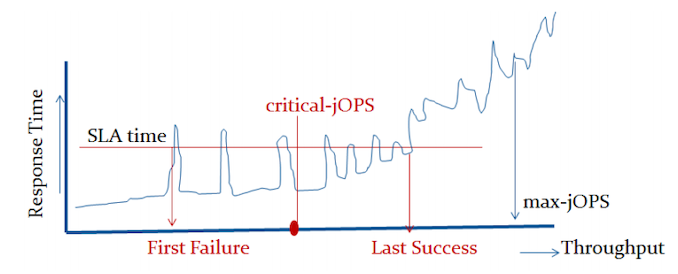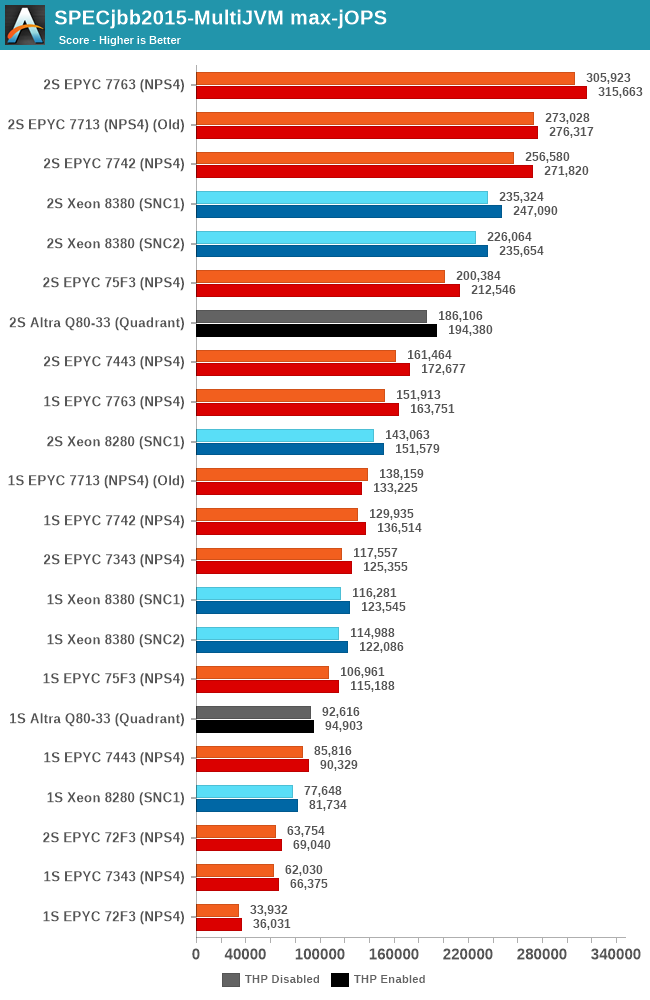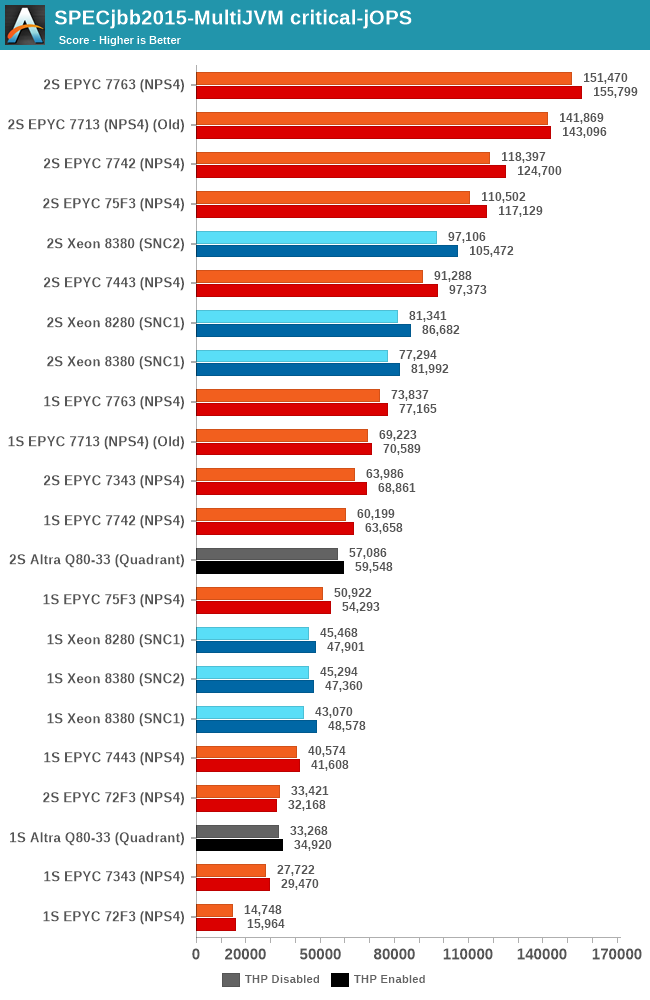AMD EPYC Milan Review Part 2: Testing 8 to 64 Cores in a Production Platform
by Andrei Frumusanu on June 25, 2021 9:30 AM ESTSPECjbb MultiJVM - Java Performance
Moving on from SPECCPU, we shift over to SPECjbb2015. SPECjbb is a from ground-up developed benchmark that aims to cover both Java performance and server-like workloads, from the SPEC website:
“The SPECjbb2015 benchmark is based on the usage model of a worldwide supermarket company with an IT infrastructure that handles a mix of point-of-sale requests, online purchases, and data-mining operations. It exercises Java 7 and higher features, using the latest data formats (XML), communication using compression, and secure messaging.
Performance metrics are provided for both pure throughput and critical throughput under service-level agreements (SLAs), with response times ranging from 10 to 100 milliseconds.”
The important thing to note here is that the workload is of a transactional nature that mostly works on the data-plane, between different Java virtual machines, and thus threads.
We’re using the MultiJVM test method where as all the benchmark components, meaning controller, server and client virtual machines are running on the same physical machine.
The JVM runtime we’re using is OpenJDK 15 on both x86 and Arm platforms, although not exactly the same sub-version, but closest we could get:
EPYC & Xeon systems:
openjdk 15 2020-09-15
OpenJDK Runtime Environment (build 15+36-Ubuntu-1)
OpenJDK 64-Bit Server VM (build 15+36-Ubuntu-1, mixed mode, sharing)
Altra system:
openjdk 15.0.1 2020-10-20
OpenJDK Runtime Environment 20.9 (build 15.0.1+9)
OpenJDK 64-Bit Server VM 20.9 (build 15.0.1+9, mixed mode, sharing)
Furthermore, we’re configuring SPECjbb’s runtime settings with the following configurables:
SPEC_OPTS_C="-Dspecjbb.group.count=$GROUP_COUNT -Dspecjbb.txi.pergroup.count=$TI_JVM_COUNT -Dspecjbb.forkjoin.workers=N -Dspecjbb.forkjoin.workers.Tier1=N -Dspecjbb.forkjoin.workers.Tier2=1 -Dspecjbb.forkjoin.workers.Tier3=16"
Where N=160 for 2S Altra test runs, N=80 for 1S Altra test runs, N=112 for 2S Xeon 8280, N=56 for 1S Xeon 8280, and N=128 for 2S and 1S on the EPYC system. The 75F3 system had the worker count reduced to 64 and 32 for 2S/1S runs, with the 7443, 7343 and 72F3 also having the same thread to core ratiio.
The Xeon 8380 was running at N=140 for 2S Xeon 8380 and N=70 for 1S - the benchmark had been erroring out at higher thread counts.
In terms of JVM options, we’re limiting ourselves to bare-bone options to keep things simple and straightforward:
EPYC & Altra systems:
JAVA_OPTS_C="-server -Xms2g -Xmx2g -Xmn1536m -XX:+UseParallelGC "
JAVA_OPTS_TI="-server -Xms2g -Xmx2g -Xmn1536m -XX:+UseParallelGC"
JAVA_OPTS_BE="-server -Xms48g -Xmx48g -Xmn42g -XX:+UseParallelGC -XX:+AlwaysPreTouch"
Xeon Cascade Lake systems:
JAVA_OPTS_C="-server -Xms2g -Xmx2g -Xmn1536m -XX:+UseParallelGC"
JAVA_OPTS_TI="-server -Xms2g -Xmx2g -Xmn1536m -XX:+UseParallelGC"
JAVA_OPTS_BE="-server -Xms172g -Xmx172g -Xmn156g -XX:+UseParallelGC -XX:+AlwaysPreTouch"
Xeon Ice Lake systems (SNC1):
JAVA_OPTS_C="-server -Xms2g -Xmx2g -Xmn1536m -XX:+UseParallelGC"
JAVA_OPTS_TI="-server -Xms2g -Xmx2g -Xmn1536m -XX:+UseParallelGC"
JAVA_OPTS_BE="-server -Xms192g -Xmx192g -Xmn168g -XX:+UseParallelGC -XX:+AlwaysPreTouch"
Xeon Ice Lake systems (SNC2):
JAVA_OPTS_C="-server -Xms2g -Xmx2g -Xmn1536m -XX:+UseParallelGC"
JAVA_OPTS_TI="-server -Xms2g -Xmx2g -Xmn1536m -XX:+UseParallelGC"
JAVA_OPTS_BE="-server -Xms96g -Xmx96g -Xmn84g -XX:+UseParallelGC -XX:+AlwaysPreTouch"
The reason the Xeon CLX system is running a larger back-end heap is because we’re running a single NUMA node per socket, while for the Altra and EPYC we’re running four NUMA nodes per socket for maximised throughput, meaning for the 2S figures we have 8 backends running for the Altra and EPYC and 2 for the Xeon, and naturally half of those numbers for the 1S benchmarks.
For the Ice Lake system, I ran both SNC1 (one NUMA node) as SNC2 (two nodes), with the corresponding scaling in the back-end memory allocation.
The back-ends and transaction injectors are affinitised to their local NUMA node with numactl –cpunodebind and –membind, while the controller is called with –interleave=all.
The max-jOPS and critical-jOPS result figures are defined as follows:
"The max-jOPS is the last successful injection rate before the first failing injection rate where the reattempt also fails. For example, if during the RT-curve phase the injection rate of 80000 passes, but the next injection rate of 90000 fails on two successive attempts, then the max-jOPS would be 80000."
"The overall critical-jOPS is computed by taking the geomean of the individual critical-jOPS computed at these five SLA points, namely:
• Critical-jOPSoverall = Geo-mean of (critical-jOPS@ 10ms, 25ms, 50ms, 75ms and 100ms response time SLAs)
During the RT curve building phase the Transaction Injector measures the 99th percentile response times at each step level for all the requests (see section 9) that are considered in the metrics computations. It then computes the Critical-jOPS for each of the above five SLA points using the following formula:
(first * nOver + last * nUnder) / (nOver + nUnder) "

That’s a lot of technicalities to explain an admittedly complex benchmark, but the gist of it is that max-jOPS represents the maximum transaction throughput of a system until further requests fail, and critical-jOPS is an aggregate geomean transaction throughput within several levels of guaranteed response times, essentially different levels of quality of service.

In the max-jOPS metric, the re-tested 7763 increases its throughput by 5%, while the 75F3 oddly enough didn’t see a notable increase.
The 7343 here doesn’t fare quite as well to the Intel competition as in prior tests, AMD’s high core-to-core latency is still a larger bottleneck in such transactional and database-like workloads compared to Intel’s monolithic mesh approach. Only the 7443 manages to have a slight edge over the 28-core Intel SKU.

In the critical-jOPS metric, both the 16- and 24-core EPYCs lose out to the 28-core Xeon. Unfortunately we don’t have the Xeon 6330 numbers here due those chips and system being in a different location.










58 Comments
View All Comments
Andrei Frumusanu - Friday, June 25, 2021 - link
Those results don't contradict anything I'm saying. Given a normalised throughput performance of the socket, for example here where the 16- and 24- core Milan equals or beats the 28-core ICL-SP in many workloads, the Xeon still handily beats those Milan parts in transactional workloads. The 40-core Xeon has 77% of the jbb performance of the 64-core EPYC even though in the int suite it's only at 60%. Those particular STH results work out because the 7543P is $1000 cheaper than the 7543, but for the SKUs we had in today, Intel still is on equal footing in terms of DB performance value.Cllaymenn - Friday, June 25, 2021 - link
Whatever one says about some insignificant single anomaly in some DB test... The fact is that ANY company, from small to large, any corporation needing power, any data centre, hosting, cloud computing, research institutes, universities, will choose EPYC on ZEN3 over even the 8320, because it will allow them to compute faster, make more money per month, and less stress for administrators when there are higher network loads, clouds because AMD will "grind" / process faster the requests/needs of thousands of of thousands of clients simultaneously using servers, because in addition to more compute power has more bandwidth AMD platform especially with 256 threads and 8 channel memory and fast Infinity Fabric and many of the ZEN3 optimizations... and is more flexible (harder to clog or jam Zen2/Zen3 from what I've noticed. ) These processors grind through anything you throw at them without any breathlessness.schujj07 - Friday, June 25, 2021 - link
While Spec is an "industry standard" benchmark, vendors spend hours optimizing for their servers to look better. Therefore as an administrator and designer of a high performance data-center I personally look at Spec results with a grain of salt. For example, Super Micro submitted data for 2 of their A+ AS-1124US-TNRP with dual 75F3 on April 26, 2021. One system has max-jOPS of 276,317 and critial-jOPS of 116,628. The other has a score of 211,179 max-jOPS & 191,813 critical-jOPS. They also have 2 X12DPG-QT6 with dual 8380's and one has scores of 272,500 for max-jOPS & 147,409 for critical-jOPS. The other has scores of 258,368 for max-jOPS & 201,334 for critical-jOPS. In these cases the 75F3 with few cores and threads ends up in a virtual tie with the 8380 in the transactional workload for one of the results, but the second result in the database is a 22-30% lower based on comparison systems. https://www.spec.org/jbb2015/results/res2021q2/Depending on the results you want, the 75F3 is a much better value or of equal value to the 8380. I think now you can see why I take Spec with a grain of salt on their results. Globally saying that Milan has issues in transactional DBs based solely on Spec results isn't a good idea. While I know it is the benchmarks that you choose as they are "industry standard," I think it would be worth while to invest in creating an actual real world scenario DB benchmark that doesn't use Spec.
Andrei Frumusanu - Friday, June 25, 2021 - link
> One system has max-jOPS of 276,317 and critial-jOPS of 116,628. The other has a score of 211,179 max-jOPS & 191,813 critical-jOPS.Which generally makes submitted scores not very useful, we're using apples-to-apples runs here, and while you can argue they're not as optimised, they're comparable to each other.
And I also never said that Milan has *issues*, I'm simply saying that compared to other workloads where there's a massive performance lead for AMD, Intel is still competitive, a view that falls in line with many industry customers.
Cllaymenn - Friday, June 25, 2021 - link
We know that Intel watches the Anandtech website, and that you are aware of this, they also send you expensive hardware for testing, and hope that the results will be more favourable to their new development (e.g. 8320) which they have been working on for a long time. I think it would be unpleasant and uncomfortable to criticise their new products harshly if I were writing a review, but I would rather gently point out which is good at what, which is leading and which still needs to catch up. Because of the awareness of the efforts of hundreds or even thousands of Intel engineers I would not have the heart to criticize their new product, or sharply, clearly say who wins everything and the rest can hide. I know that even the engineers, designers and CPU architects like to read about their new baby after work, and they go to sites like Anandtech with enthusiasm and quiet hope that they have made a better impression on the reviewer and readers, than their previous older products, that we have noticed a significant difference, jump in performance and that it has been appreciated and maybe there will be some nice, positive comments, feedback. It probably gives them a lot of happiness to see people out there enjoying the results of their hard work and another success for the company. Because the 8320 was a huge challenge for these people, it's a brand new fresh 10nm SuperFin technology and a mega monolithic 40 core big piece of silicon. And it works! It may not catch up with the 64 core competition but it's still a huge step forward for them, reaching a significant milestone. Once they mastered this SuperFin 10nm technology to create monolithic 40 core chips they now have a lot of experience and know how to do it even better, especially in a modular architecture where the silicon pieces will be smaller. Many of the threads stem from the creation of the Xeon 8320, so I understand the reviewer's attitude of appreciating the level of technology, sophistication, and performance of their new design. (sorry for some grammatical errors, I'm still improving)bwhitty - Friday, June 25, 2021 - link
Can't tell if you're very subtly implying Andrei is coloring the results in favor of Intel? Perhaps you're not, but anyways it doesn't seem he is. Other than that, I agree thatSmall correction: Ice Lake is on 10nm+, not Super Fin. Tiger Lake is 10SF (10++), and Sapphire Rapids will be on 10 Enhance Super Fin, so 10nm+++.
Tangent: I think that Ice Lake being on the non-SF process actually bodes extremely well for Sapphire Rapids because Ice Lake even in laptops is just not that good from a mfg perspective. It's basically Intel 10nm's first shippable and salvaged process. Super Fin appears far, far better in Tiger Lake versus Ice Lake, and so an improvement on top of that thusly should perhaps finally bring Intel's mfg in line with TSMC 7nm. That gives Sapphire Rapids a good place to be in the first half of 2022 until Genoa rolls out on TSMC 5nm is late 2022 / early 2023.
Cllaymenn - Friday, June 25, 2021 - link
bwhitty. I did not mean favoring Intel products, but a more subdued way of speaking about their performance in relation to ZEN3, a way other than the popular Linus on YT, which is sharply pressing Intel with each premiere of new AMD products.As for Super Fin, I read about it recently in one of the popular IT websites. I typed in google and found a quote
"Intel Xeon Scalable Ice Lake-SP processors were announced some time ago, but we had to wait a while for their premiere. We finally got it - we got to know the technical details of the units, as well as their performance results. Intel Xeon Scalable units (Ice Lake-SP) use the new Sunny Cove microarchitecture, which is expected to translate into up to a 20% increase in IPC over the previous generation Skylake. The chipsets are manufactured using a new 10nm SuperFin process.
As I checked with a few other sources, I now know that this site was wrong about the 83xx series.
Ian Cutress - Friday, June 25, 2021 - link
On 10nm naming, Intel has changed it twice. There are no + or ++ any more.https://www.anandtech.com/show/16107/what-products...
bwhitty - Monday, June 28, 2021 - link
Oh yes, Dr Cutress, I know all these Intel mfg node specifics purely from Anandtech’s breakdownsoutsideloop - Friday, June 25, 2021 - link
Far, far better? Tiger Lake H still sucks power like an anebriated Cleopatra.